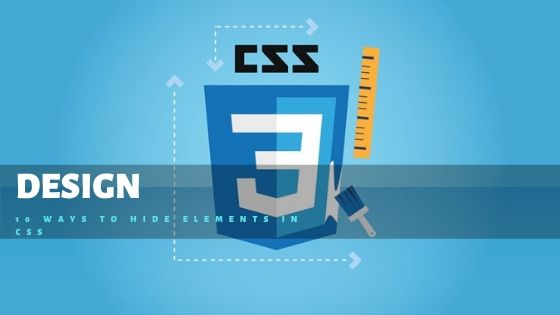Table of Contents
There are numerous alternatives for users to hide elements in CSS. These methods vary in the manner in which they influence approachability, design, animation, execution, and incidence treatment.
Animation
- A few CSS hiding choices work completely or partially. The component is either completely noticeable or completely hidden and there are no events in-between. Other options, such as transparence, can offer a variety of conditions, by which inserted CSS animations turn feasible.
Easy-Of-Use
- Every technique outlined below will visibly suppress a component, but it might or might not conceal the elements from supporting applications. For instance, a screen reader can furthermore declare miniature understandable textual content. Additional CSS characteristics or ARIA properties like aria-hidden=”true” might be required to specify the relevant activity and to hide text CSS.
- It is important to remain cautious because animations can likewise result in dizziness, headaches, convulsions, and other bodily distress for many people. Contemplate utilizing a ‘prefers-reduced-motion’ means inquiry to turn animations off when defined in a user’s inclinations.
Incident Treatment
- Concealing will either halt incidents from getting activated on that component or have no impact, implying that the component is not apparent but can nevertheless be clicked on or obtain different user communications.
Performance
- Subsequent to a browser loading and parsing the HTML DOM and CSS target model, the page is executed in three degrees, namely –
- Layout
‘Layout’ creates the geometry and setting of individual components . - Paint
‘Paint’ assists in sketching the pixels for every component. - Composition
‘Composition’ helps in placing constituent panels in the relevant system.
- Layout
An outcome which simply prompts style variances is visibly more fluid than those influencing the design. In a few instances, the browser can additionally utilize hardware speedups.
The ‘opacity’ Attribute
- The opacity: N and filter: opacity(N) resources can be given values between 0 and 1, or else a rate within 0 and 100 percent. This indicates completely lucid and thoroughly concealed respectively.
- There is also limited functional distinction within the two in contemporary browsers. Despite the fact that the filter must be applied if various outcomes are implemented at the same rate. These include blur, grayscale, contrast, etc. The ‘opacity’ attribute is capable of being animated and grants excellent execution, although be cautious that a completely see-through component persists on the page and is capable of executing incidents.
Alpha Channel Attribute
- The ‘opacity’ attribute helps to entire hide elements in CSS, although it is additionally reasonable to establish the border-color, background-color, and color fields independently. Implementing a zero alpha channel utilizing an rgba(0,0,0,0) value or something alike executes an object as completely invisible.
- Every feature can be animated independently to generate exciting outcomes. Regard that invisibility cannot be utilized for components with picture backdrops except they are created applying ‘linear-gradient’ or something similar.
- The alpha channel can be established with the following – Transparent
Completely transparent (doing so in the middle of animations is not accommodated).
rgba(r, g, b, a)
Stands for Red, Green, Blue, and Alpha value.
hsla(h, s, l, a)
Stands for Hue, Saturation, Lightness, and Alpha value. #RRGGBBAA and #RGBA values
The ‘transform’ Attribute
- The ‘transform’ attribute can be utilized to transpose (shift), measure, exchange or skew a component. A measure(0) or transpose (-800px, 0px) off-screen will conceal the component.
- The ‘transform’ attribute provides outstanding execution and device speedups owing to the fact that the component is definitely transferred into an individual panel and can be animated in either 2d or 3d. The fundamental design area persists, although no incidents will be executed by a completely concealed component.
The ‘clip-path’ Attribute
- The ‘clip-path’ attribute produces a cutting area that defines what components of detail are evident. Applying a condition for the ‘clip-path’ attribute by mentioning the value of ‘circle’ as null will ultimately result in the concealing of the detail.
- The ‘clip-path’ attribute provides the possibility for engaging animations, despite the fact that it must only be dependant on while using contemporary browsers.
The ‘visibility’ Attribute
- The ‘visibility’ attribute can be placed to apparent or concealed in order to reveal and conceal a component.
- The area utilized by the component persists in place except a breakdown condition is applied.
The ‘display’ Attribute
- The ‘display’ attribute is presumably the most-utilized method available to hide elements in CSS. A null value completely eliminates the component as though it never endured inside the DOM.
- Nevertheless, it is probably the most damaging CSS feature to apply in the bulk of states. It cannot be animated and will also execute a page design except the component is transferred out of the page current utilizing the site, in which case complete or the brand-new ‘contain’ attribute is chosen.
- The ‘display’ attribute is likewise loaded, with alternatives including table, grid, flexbox, block, and inline, amongst many others. Returning to the conventional utility after setting the value of ‘display’ as null, can prove to be uncertain. The attribute ‘unset’ might offer some assistance in this regard.
The Hidden Property Within HTML
- Another important feature to hide elements in CSS, is the HTML ‘hidden’ attribute, which can be attached to any component. This can be executed through the HTML code below <p hidden>
‘Hidden content’
<p hidden> - In order to implement the browser’s default behavior, use the following code
[hidden] {
display: none;
} - This offers the identical advantages and imperfections as giving a null value to the ‘display’ attribute, despite the fact that it can be beneficial when utilizing a content administration policy that does not allow style variations.
- Another important feature to hide elements in CSS, is the HTML ‘hidden’ attribute, which can be attached to any component. This can be executed through the HTML code below <p hidden>
The ‘position’ Attribute
- The ‘position’ attribute makes it possible for a component to be shifted from its default inactive state within a page design utilizing right, left, bottom, and top. Any element can consequently be transferred by setting a value for the left component of ‘position’ as -800 px or an equivalent value.
Overlay Another Element
- A component can be completely concealed by placing an added element on the top of the first one, provided it has an identical shade as that of the backdrop. For instance, an ‘::after’ false-component can be included, despite the fact that any subcomponent can also be applied. While technically feasible, this decision necessitates extra code than other alternatives.
Decrease The Dimensions Of The Elements You Wish To Hide
- A component can be concealed by decreasing its dimensions utilizing attributes including padding, width, border-width, font-size, and height. It might additionally be required to implement the ‘overflow’ value as hidden in order to guarantee that the content does not scatter.
- Fascinating animated outcomes are feasible, but the execution is seemingly more enjoyable with ‘transform’.
Applying a null value to the ‘display’ attribute has by far been the ideal answer to conceal components for several years now. However, in recent times, it has been replaced by more adaptable options. Although it remains efficient, it is utilized possibly only when designers wish to forever conceal elements. The ‘transform’ and ‘opacity’ attributes are more suitable alternatives with regards to performance. Get in touch with us Open Designs India, today! We’d love to talk to you about how our Frontend Development Services can be of assistance to your organization, in seeing every one of its goals and visions come to fruition.








